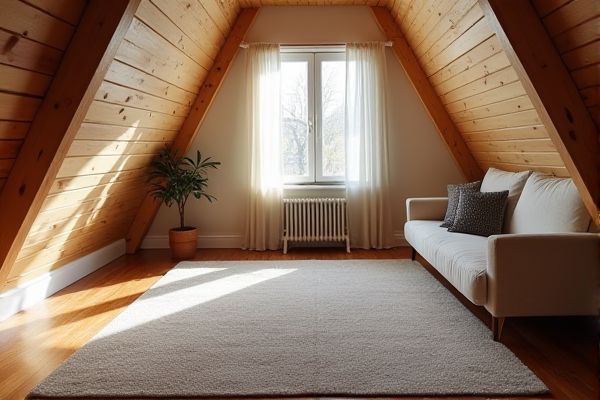
Attic area rugs offer flexibility in design and easy movement, allowing you to change the look and feel of your space effortlessly, while attic carpet tiles provide durability, insulation, and a more permanent flooring solution that can be replaced individually when damaged. Discover which option best suits your attic's needs and enhances your comfort by reading the rest of this article.
Table of Comparison
| Feature | Attic Area Rug | Attic Carpet Tiles |
|---|---|---|
| Installation | Easily placed and moved; no adhesive required | Modular installation; requires adhesive or peel-and-stick backing |
| Customization | Limited size and shape options | Highly customizable layout and size |
| Durability | Less durable in high-traffic attic zones | More durable; designed for heavy use and easy replacement |
| Maintenance | Easy to clean; can be removed for deep cleaning | Individual tiles replaceable; spot cleaning preferred |
| Cost | Generally lower upfront cost | Higher initial investment but cost-effective long-term |
| Insulation | Moderate insulation benefits | Better insulation with multiple layers |
| Aesthetic Flexibility | Variety of colors and patterns available | Wide range of styles with mix-and-match potential |
Introduction to Attic Flooring Options
Attic flooring options include area rugs and carpet tiles, each offering unique benefits for insulation and comfort. Area rugs provide a soft, decorative layer that can be easily moved or replaced, while carpet tiles offer customizable durability and easier maintenance. Choosing the right flooring depends on your attic's usage, insulation needs, and personal style preferences.
What Are Attic Area Rugs?
Attic area rugs are versatile floor coverings designed to add warmth, comfort, and style to your attic space without the need for permanent installation. These rugs come in various sizes, patterns, and materials, allowing you to customize the look and feel of your attic while protecting the original flooring. Unlike attic carpet tiles, area rugs can be easily moved or replaced, offering flexible design options for enhancing your attic's aesthetic and functionality.
Understanding Attic Carpet Tiles
Attic carpet tiles offer a practical and customizable flooring solution compared to traditional attic area rugs, providing easier installation and replacement in tight or irregular attic spaces. These tiles often come with durable, insulating materials designed to enhance comfort and energy efficiency within your attic. Choosing carpet tiles allows you to tailor patterns and textures to match your attic's specific needs, improving both aesthetics and functionality.
Key Differences Between Area Rugs and Carpet Tiles
Area rugs in your attic provide a large, continuous surface that adds warmth and style without permanent installation, ideal for flexible design changes. Carpet tiles offer modularity, easy replacement, and customization, making them practical for high-traffic zones or uneven floors in attic spaces. Both options improve insulation and comfort, but area rugs excel in aesthetic appeal while carpet tiles prioritize durability and maintenance.
Installation Process: Area Rugs vs Carpet Tiles
Attic area rugs require minimal installation, often needing only placement and occasional adjustment, making them ideal for quick, flexible floor coverage. Carpet tiles involve a more involved installation process, including measuring, aligning, and adhering tiles to the attic floor, offering a customizable and durable solution. While area rugs provide easy removal and repositioning, carpet tiles offer better stability and coverage for high-traffic attic spaces.
Insulation and Comfort Comparison
Attic area rugs provide a soft, layered insulation that helps retain heat while adding comfort underfoot, making them ideal for smaller or accent spaces. Attic carpet tiles offer modular insulation with customizable coverage, allowing targeted warmth and cushioning across the attic floor. Both options improve thermal efficiency but carpet tiles typically deliver more uniform comfort and easier maintenance in larger attic areas.
Maintenance and Cleaning Requirements
Attic area rugs require regular vacuuming and occasional spot cleaning to maintain their appearance, with the added benefit of easy removal for deep cleaning or airing out. In contrast, attic carpet tiles offer greater convenience in maintenance since individual tiles can be replaced if stained or damaged, minimizing the need for whole-area cleaning. Both options demand attention to dust and debris typically found in attic spaces, but carpet tiles provide a more modular, low-maintenance solution.
Design Flexibility and Style Choices
Attic area rugs offer exceptional design flexibility with the ability to easily change patterns, colors, and textures to suit evolving interior styles, making them ideal for seasonal updates or personal expression. Attic carpet tiles provide modular style choices, allowing for customized layouts and the combination of multiple designs within a single space, enhancing creativity in small or irregular attic areas. Both options accommodate diverse aesthetic preferences, but carpet tiles excel in adaptability for specific attic dimensions and complex floor plans.
Durability and Longevity in Attic Settings
Attic area rugs, made from high-quality materials like wool or synthetic fibers, offer moderate durability but may wear faster due to limited backing strength and frequent foot traffic. Carpet tiles designed specifically for attic use provide enhanced longevity with their strong adhesive backing and modular construction, allowing easy replacement of damaged sections without full-floor reinstallation. Both options require consideration of attic humidity and temperature fluctuations, but carpet tiles generally withstand these conditions better, ensuring extended durability in attic environments.
Cost Considerations: Area Rugs vs Carpet Tiles
Area rugs in attic spaces generally offer a lower upfront cost with easier installation, suitable for budget-conscious homeowners seeking quick updates. Carpet tiles, while often more expensive initially, provide greater durability and easier maintenance, allowing for selective replacement of damaged sections in high-traffic attic zones. Selecting between area rugs and carpet tiles hinges on balancing immediate budget constraints with long-term performance and upkeep expenses.
 homyna.com
homyna.com